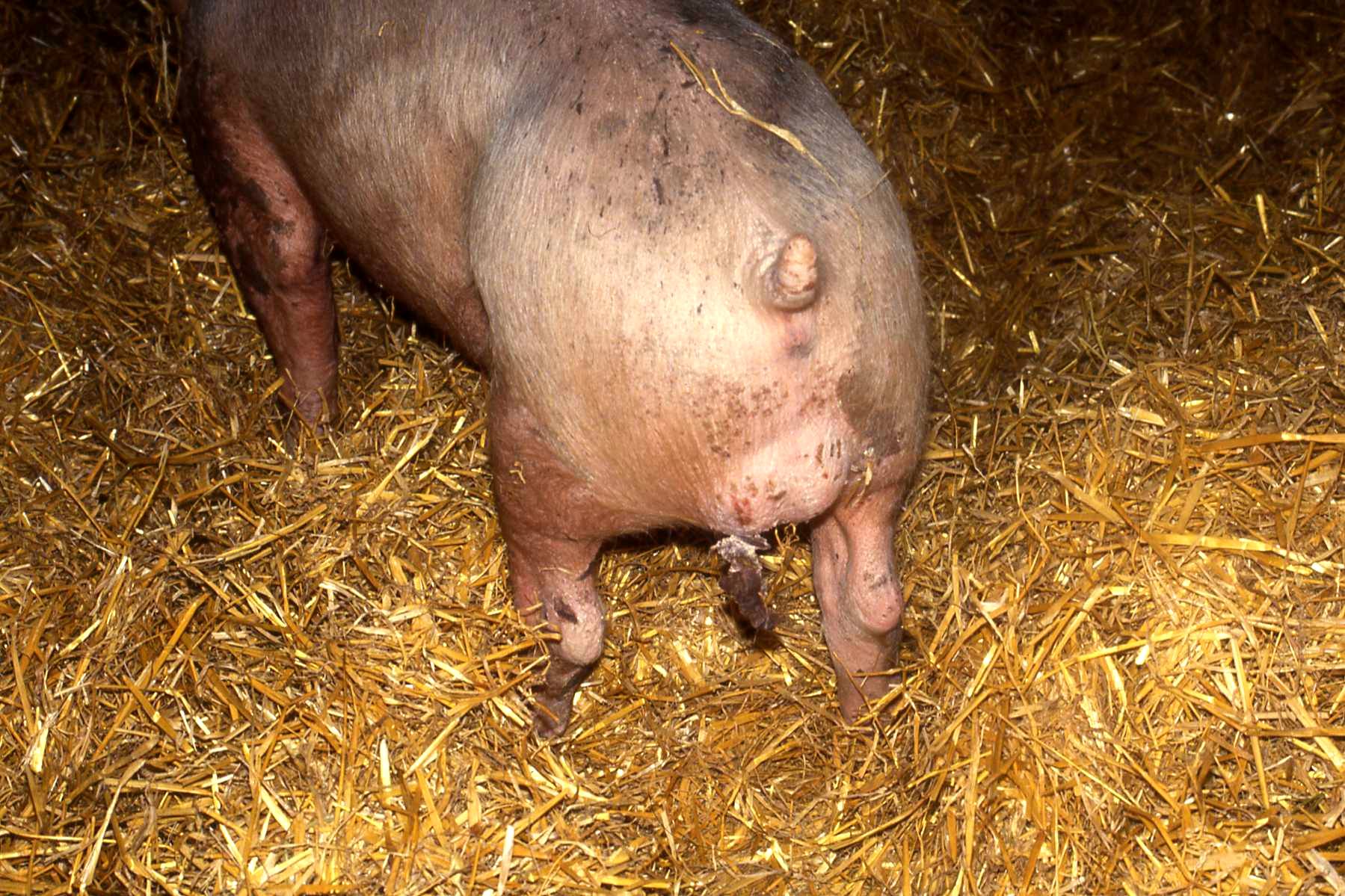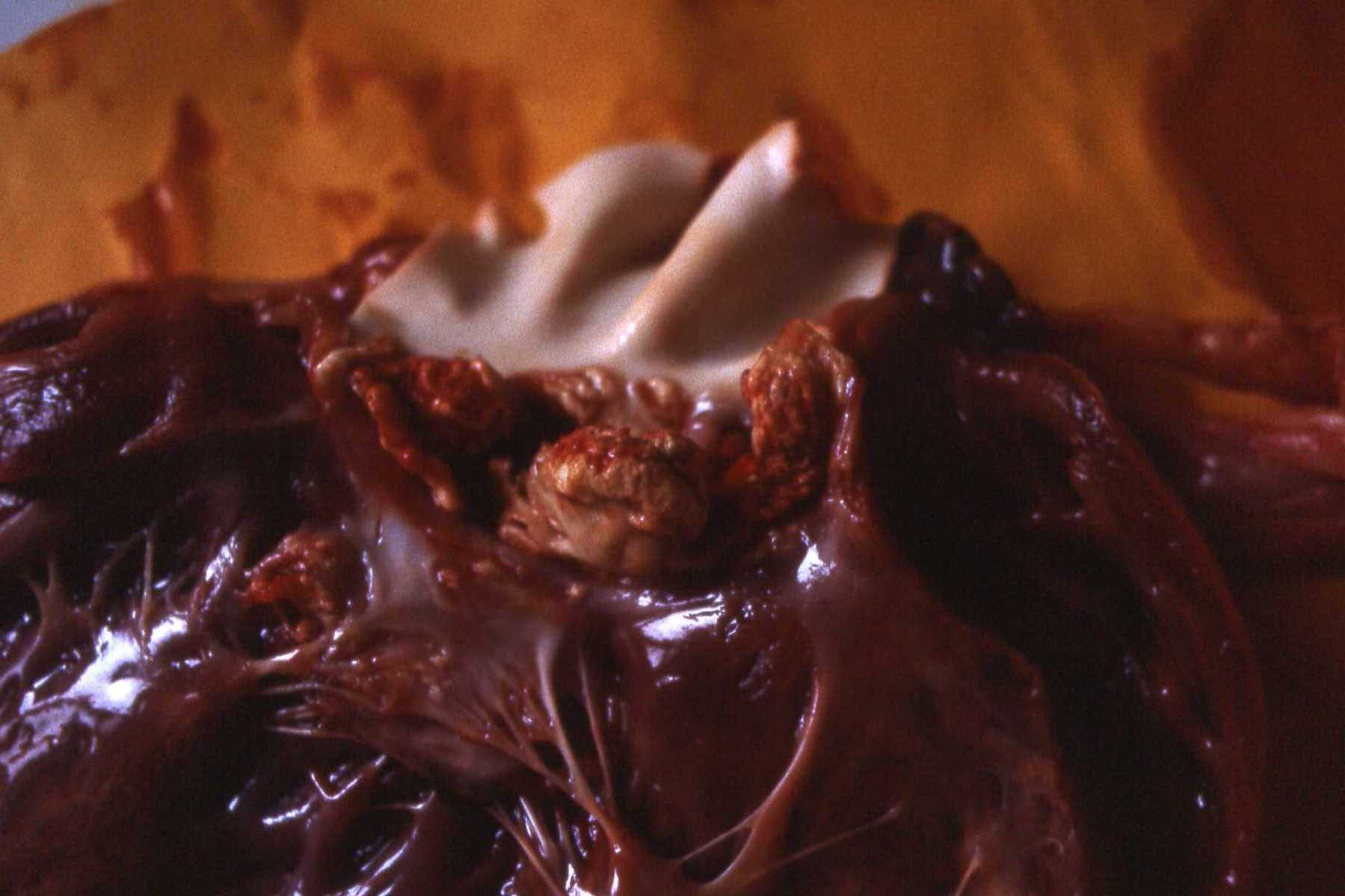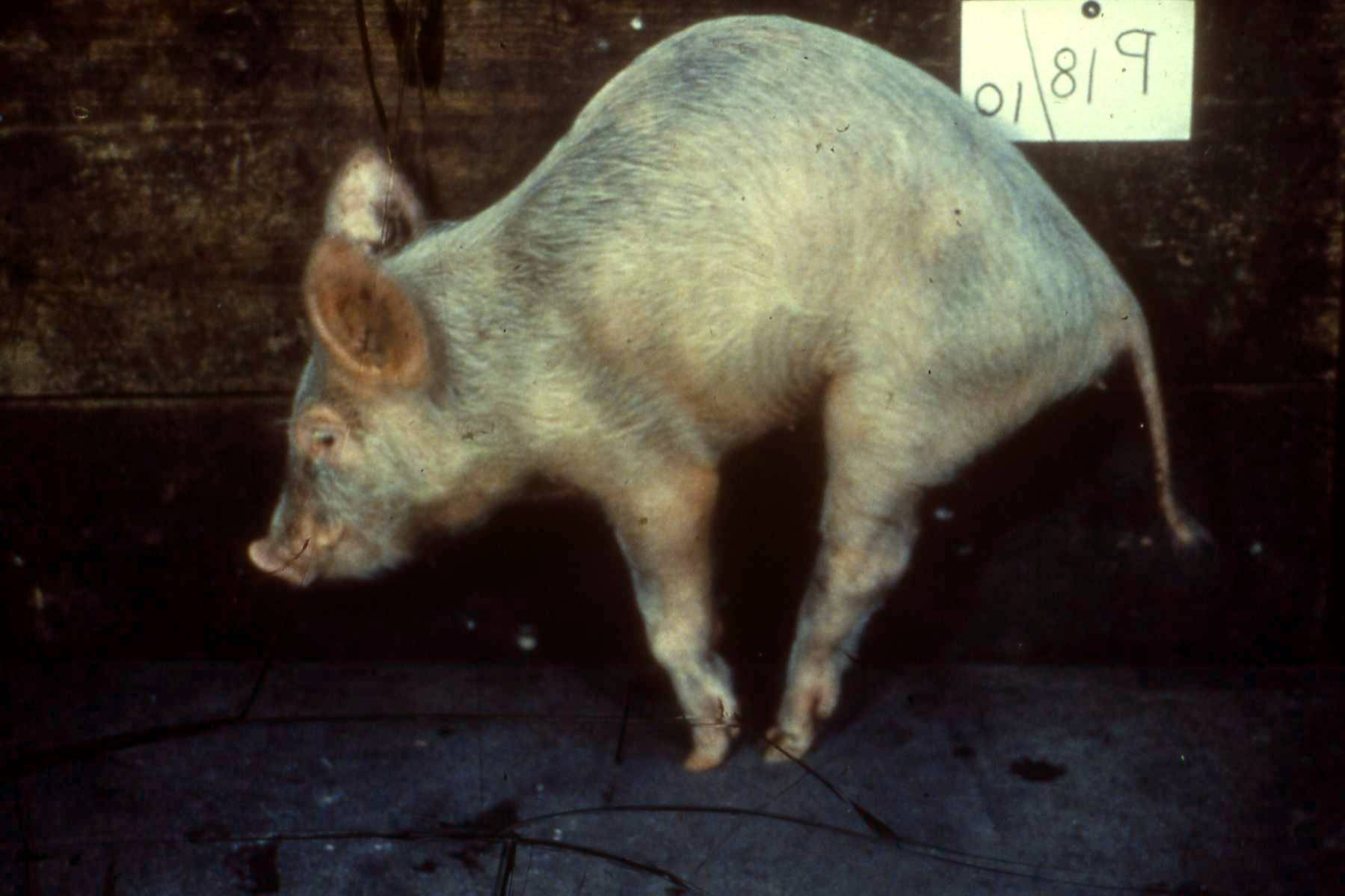Erysipelas is a long recognised bacterial disease of pigs and represents one of the most common clinical problems encountered in pigs kept in small populations such as smallholdings, hobby farms and specialist pedigree small herds.
It is also seen occasionally in individual pigs kept as pets and can prove fatal. The reasons for its prevalence in these types of pig keeping enterprises are:
- The pigs' particular sensitivity to the disease.
- The harbouring and prevalence of Erysipelas in other farm species - particularly turkeys and sheep - to which "back yard" pigs may have access.
- The ubiquitous nature of the organism in wild animal populations that contaminate the pig keeping area and its survival in soil.

Fig 1: Sloughing of the skin of the scrotum secondary to necrosis following Erysipelas infection

Fig 2: Sloughing of the skin of the neck secondary to necrosis following Erysipelas infection
It is however also seen regularly in commercial pig farms particularly in open pen straw yard systems typically found in the UK. In commercial farms it is most commonly seen on adults and in grower finisher pigs but can affect all ages. The causative organism of Erysipelas in pigs is the ubiquitous bacterium Erysipelothrix rhusiopathiae, formally known as Erysipelas insidiosa of which there are many serotypes which may account in part for the variations in presentation of disease. Serotypes 1 & 2 are most commonly found - especially in systemic disease - and are typically incorporated in commercial vaccines. The bacterium can survive in soil or dung for 6 months or more but probably more significantly is carried by a wide range of wild birds, as well as rodents, especially mice. Pigs are particularly susceptible to disease with this organism and the classical manifestations are the acute, septicaemic form producing sudden deaths or in milder cases "diamonds". These forms of the disease can be controlled by a combination of hygiene, medication and vaccination.
Additionally, chronic (long term) changes can occur in pigs challenged with Erysipelas and present in 3 forms:
- Endocarditis - the development of 'cauliflower' like lesions on heart valves that leads to death (often sudden) due to heart failure. Surviving pigs are likely to be condemned at slaughter. Other bacteria can cause such lesions (e.g. Strep suis).
- Arthritis - a complicated form of the disease which can be very difficult to control. The difficulties arise because, in most cases, it is not the direct result of infection in joints with the organism. Erysipelas arthritis is what is termed as immune mediated or hypersensitivity reaction.
The most significant factor clinically is that because the arthritis results from an immune medicated condition, it is not necessarily the case that the acute form of the disease will be seen prior to it. Moreover, it can occur in partially immune animals (i.e. pigs that are already sensitised to the organism) and, thus, can even occur following prior vaccination. - Skin necrosis - developing in a similar way to the arthritic form in which ischaemic damage to the skin occurs, leading to death of the tissues and sloughing of the skin. It can lead to loss of extremities, especially the ears but also scrotum and any other areas (figs 1 & 2).
In adult breeding animals, all of these forms of the disease can be seen although the arthritic form is rare in sows other than those at the beginning of their breeding life. Additionally, infertility can occur in affected sows (particularly those showing other clinical signs around serving time) and in established pregnant animals, abortion can occur without any other clinical signs presented. Rarely piglets may be born infected and affected if the sow has been challenged in late pregnancy.
Clinical Signs
The range of manifestations of Erysipelas seen mean that clinical presentation can vary.
- Peracute disease - sudden death due to acute septicaemia.
- 'Diamonds' - the classic acute form of the disease. This is also a septicamaemic form, albeit milder, in which raised red 'diamond' shaped lesions appear particularly over the back (fig 3). The pig may have a very high temperature (42ºC+), be depressed and inappetent. Pigs so affected or those in contact can develop chronic signs such as skin sloughing (figs 1 & 2) or may be found dead 4 - 10 days later (possibly having appeared to recover) as a result of endocarditis (fig 4). Any pig sent for slaughter with diamond lesions still evident in the skin is likely to require skinning with resultant weight deduction and downgrading.
- Arthritis -The animal will rarely have a temperature and classical diamonds may not have been seen in the individual or pen mates. The arthritis produces a very severe lameness - particularly evident in the hind legs but rather than producing a pig that is "off its legs", the legs stiffen and become very upright. The joints in the spine may also be affected, producing a hunched look where the back legs "bunny hop". Whilst appropriate treatment in the early stages - as prescribed by the veterinary surgeon - can arrest the damage, once they reach this crippled state, recovery is unlikely. The animals may not be fit to transport and require on farm destruction but mild cases, which can be very common, may simply produce an awkward gait.
- Breeding problems. This can be presented either as waves of return to service - possibly with preceding clinical disease such as 'diamonds' - or as abortion at any stage of pregnancy often without preceding signs in affected animals or pen mates. Boars are also vulnerable to the disease and given that very high fever can occur this may render the boar infertile for up to 6 - 8 weeks, with implications for herd fertility.

Fig 3: Classic 'diamonds' in a growing pig

Fig 4: 'Cauliflower' growths on heart valves (Endocarditis)

Fig 5: Crippling, irreversible arthritis in a growing pig (photo courtesy W J Smith)
Circumstances
Erysipelas is particularly evident in systems that allow or promote:
1. Contact with bird faeces
2. Mouse contamination
3. Access to solid muck
In practice, this means that the disease is most prevalent in straw based systems, particularly in open barns (i.e. the supposed welfare friendly pig keeping systems) and tends to peak in the summer months, although can occur at any time.
In small populations kept in back yards, orchards or paddocks there is plenty of opportunity for access by birds and rodents and the persistence of the organism in soil favours persistence of disease.
Treatment
The acute disease (diamonds, abortion) is relatively easily and effectively treated with narrow spectrum penicillin-based antibiotics, either given by injection, in water or in feed depending on the extent and duration of the outbreak. A full course of treatment must be given - whilst a single short acting dose of penicillin by injection will often rapidly lead to apparent recovery (i.e. reduced temperature, return of appetite) failure to provide 3 - 5 days treatment can lead to chronic signs or re-emergence.
In outbreaks of peracute, acute and endocarditic forms of the disease it is appropriate to treat the entire population metaphyllacticly using penicillin based antibiotics in feed or water.
Treatment of chronically lame pigs is often disappointing - antibiotics are rarely effective against Erysipelas lameness but use of NSAID or even cortisone can give relief from pain.
Control
Safe and effective vaccines are available and are very cheap. Considering the high risk of Erysipelas to pigs, particularly in straw based, and back yard outdoor systems, it is an essential component of any health programme to vaccinate all breeding stock (gilts, sows and boars) to prevent the disease. A primary 2 dose course, with appropriate interval, should be followed by boosters for sows every parity and every 6 months for boars. Sow boosters are often given at weaning although protection of the offspring up to 8 - 10 weeks of age can better be achieved by vaccinating 2 - 3 weeks before farrowing. For sows, vaccines are available in combination with other pathogens.
In rare cases the strain involved may not be covered by a commercial vaccine in which case if the problem persists in a herd an autogenous vaccine may be required produced under special licence using the specific farm isolate.
In high-risk situations, vaccination of young stock from 6 weeks of age (either with a single dose or, if necessary, a 2 dose course) can be applied.
The key to preventing Erysipelas arthritis rests in limiting exposure to the organism, which can come from several sources (i.e. birds, mice and other pigs).
Bird scarers, bird netting, proximity of birds of prey and coverage of feed hoppers etc will all reduce the chances that feed will become contaminated with bird faeces. Likewise, a vigorous rodent control programme is essential. (This also has benefits for Salmonella control and other biosecurity issues).
Hygiene is also vitally important and where disease has occurred and ground becomes contaminated, a rest period of more than six months may be appropriate. Washing and disinfecting of pens, stys or compounds, where feasible is also advisable.
Avoid bird and rodent contamination of feed storage area.
Conclusion
Erysipelas is a common infectious disease affecting all ages of pigs and is a particular problem in small populations that are not protected by vaccination. Whilst serious and potentially fatal, the acute form of the disease responds well to appropriate antibiotic treatment and the disease can be easily and cheaply prevented by applying a routine vaccination regime.

